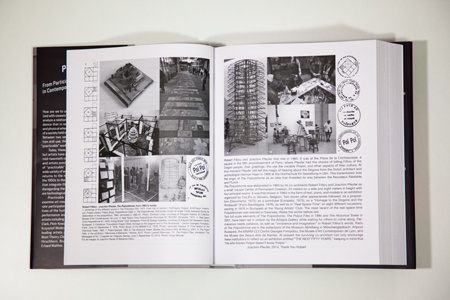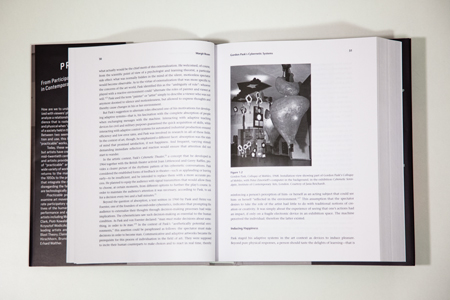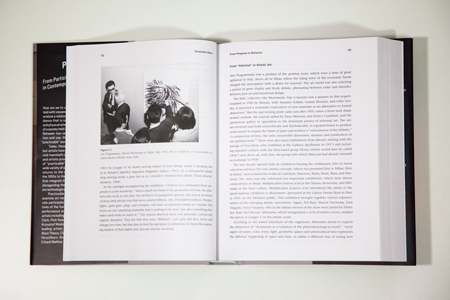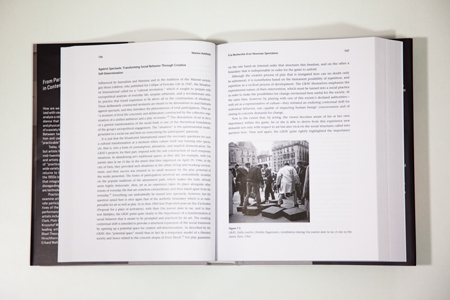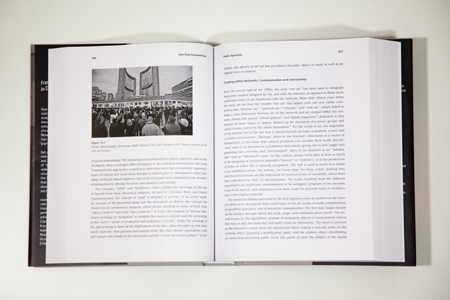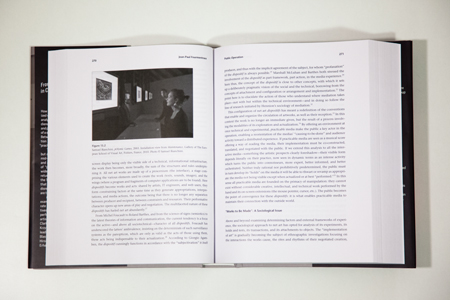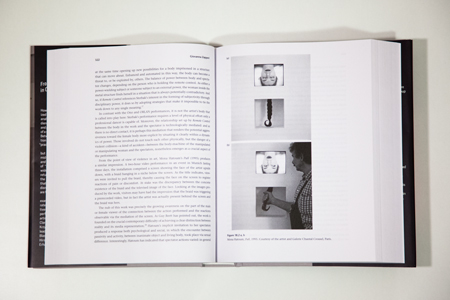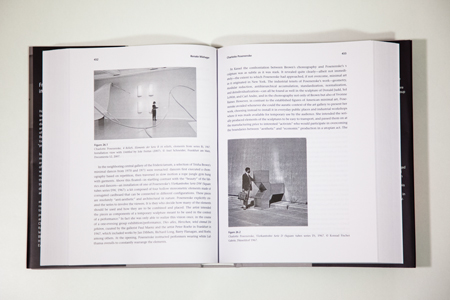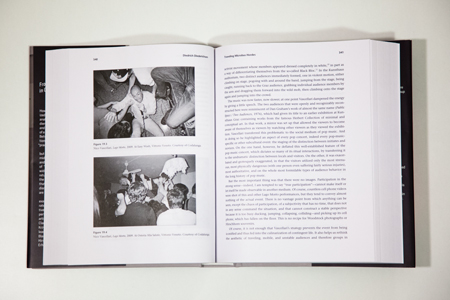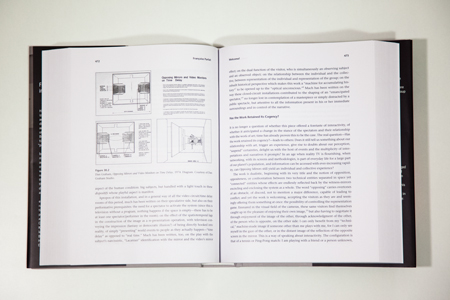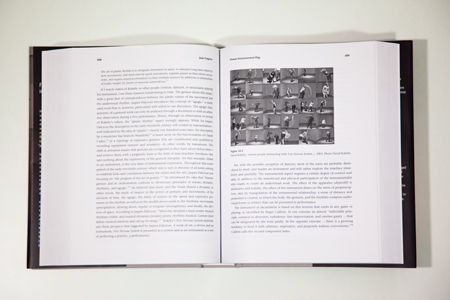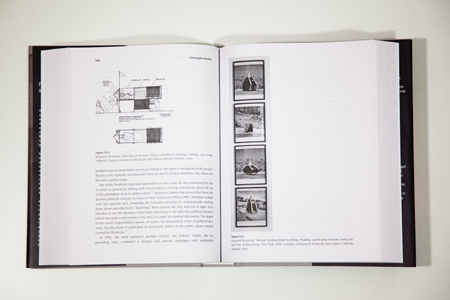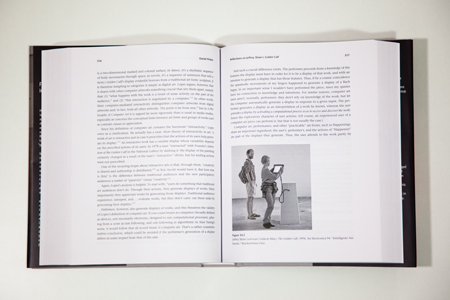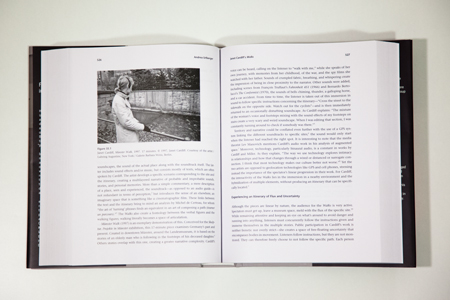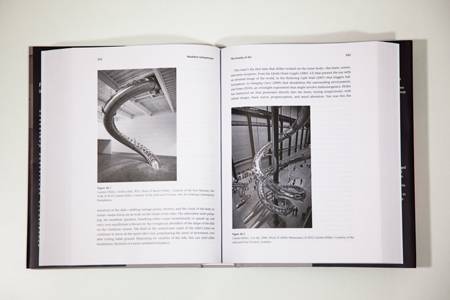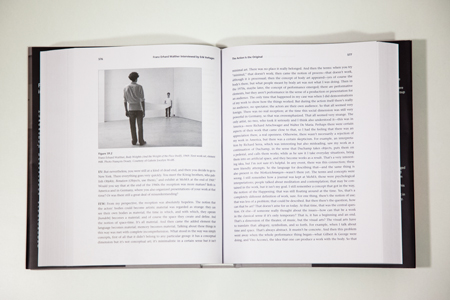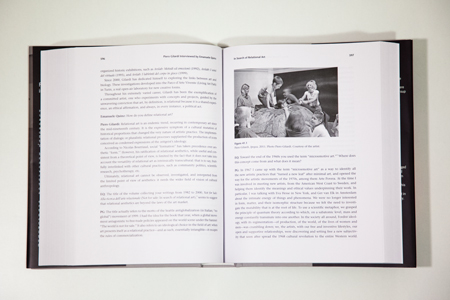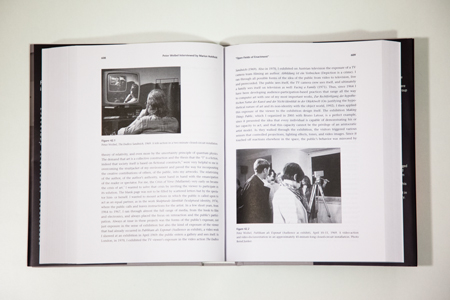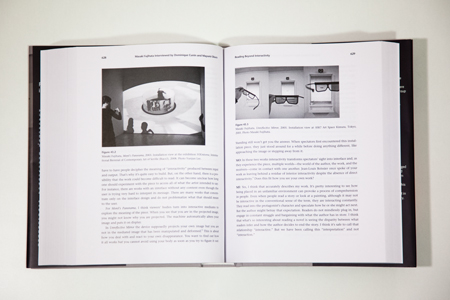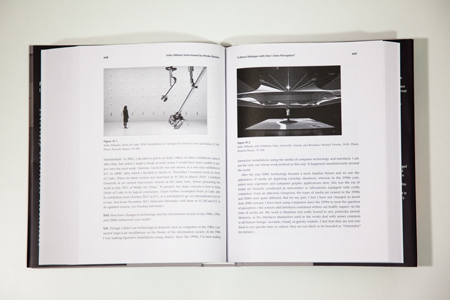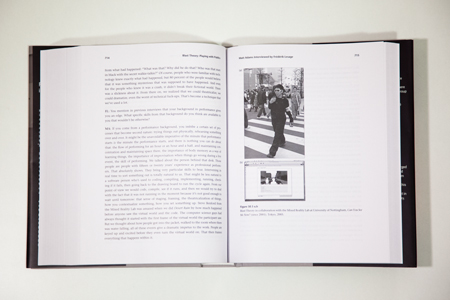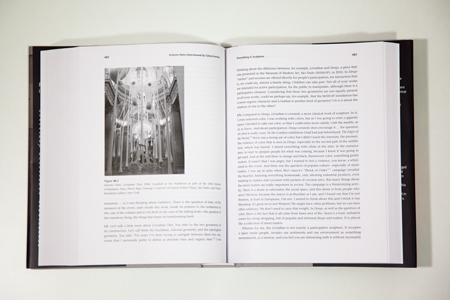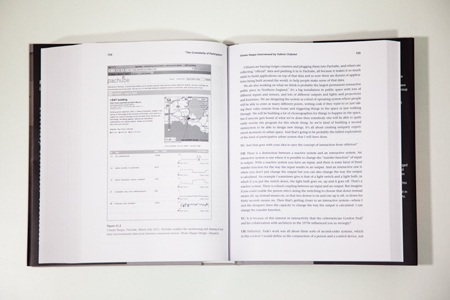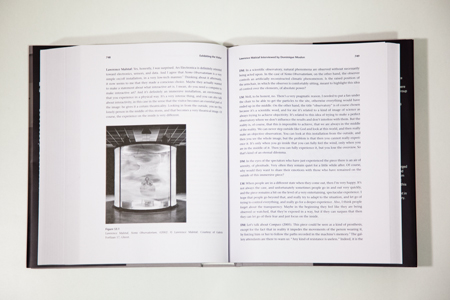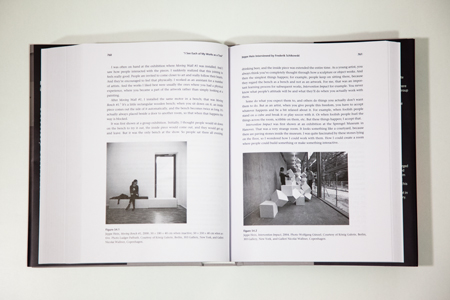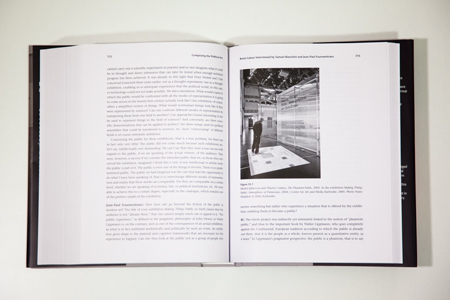25.01.2017
book: PRACTICABLE
From Participation to Interaction in Contemporary Art
Samuel Bianchini and Erik Verhagen, editors
with the collaboration of Nathalie Delbard and Larisa Dryansky.
Published by MIT Press, Leonardo Book Series.
952 pp. | 7 x 9 in | 164 b&w illus. | October 2016
Hardcover | $50.00 | £41.95 | ISBN: 9780262034753
For more informations and to buy: https://mitpress.mit.edu/books/practicable
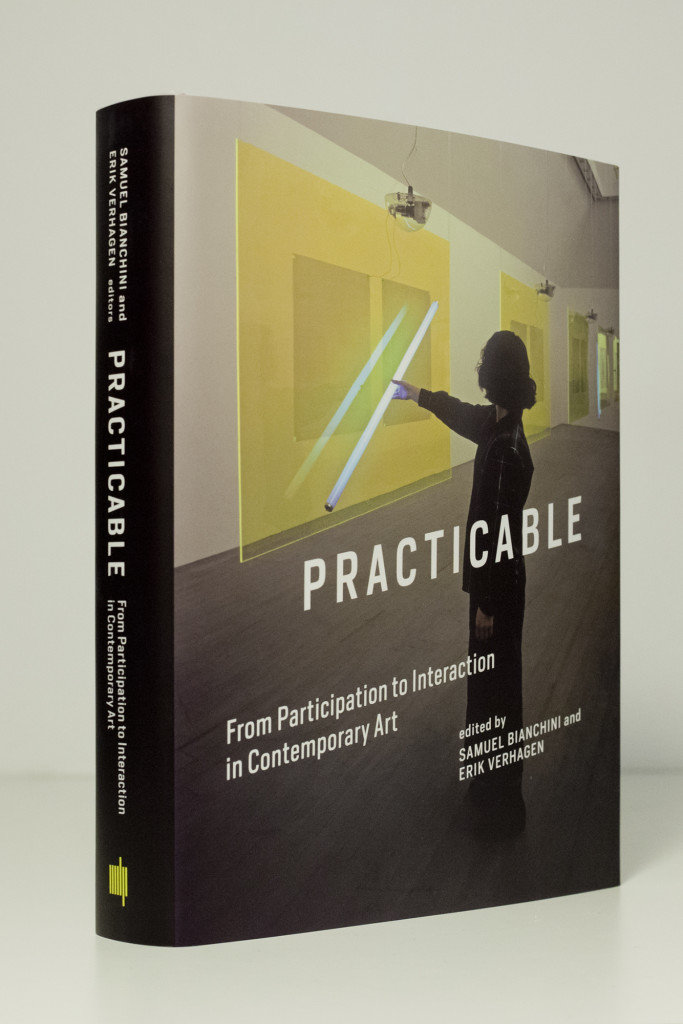
Cover image: Piotr Kowalski, Mesures à prendre (Measure to be taken), 1969
Courtesy of Andrea Kowalski
How are we to understand works of art that are realized with viewers’ physical involvement? How are we to analyze a relationship between a work of art and its audience that is rooted in an experience both aesthetic and physical when “user experience” is a central concern of a society held in the grip of omnipresent interactivity? Between two seemingly opposed modes, contemplation and use, this book offers a third option: that of “practicable” works, made for and of audience action. Today, these works often use digital technologies, but artists have created participatory works since the mid-twentieth century. In this volume, critics, writers, and artists provide diverse perspectives on this kind of “practicable” art, discussing and documenting a wide variety of works from recent decades. Practicable returns to the mainstays of contemporary art from the 1950s to the present, examining artistic practices that integrate the most forward-looking technologies, disregarding the false division between artworks that are technologically mediated and those that are not. Practicable proposes a historical framework to examine art movements and tendencies that incorporate participatory strategies, drawing on the perspectives of the humanities and sciences. It investigates performance and exhibition, as well as key works by artists including Marina Abramović, Janet Cardiff, Lygia Clark, Piotr Kowalski, Robert Morris, David Rokeby, and Krzysztof Wodiczko, and features interviews with such leading artists and theoreticians as Matt Adams of Blast Theory, Claire Bishop, Nicolas Bourriaud, Thomas Hirschhorn, Bruno Latour, Seiko Mikami, and Franz Erhard Walther.
Contributors
Matt Adams (Blast Theory), Jean-Christophe Bailly, Samuel Bianchini, Claire Bishop, Jean-Louis Boissier, Nicolas Bourriaud, Christophe Charles, Valérie Châtelet, Jean-Pierre Cometti, Sarah Cook, Jordan Crandall, Dominique Cunin, Nathalie Delbard, Anna Dezeuze, Diedrich Diederichsen, Christophe Domino, Larisa Dryansky, Glória Ferreira, Jean-Paul Fourmentraux, Gilles Froger, Masaki Fujihata, Jean Gagnon, Katrin Gattinger, Jochen Gerz, Piero Gilardi, Véronique Goudinoux, Usman Haque, Helen Evans and Heiko Hansen (HeHe), Jeppe Hein, Thomas Hirschhorn, Marion Hohlfeldt, Pierre-Damien Huyghe, Judith Ickowicz, Eric Kluitenberg, Janet Kraynak, Bruno Latour, Christophe Leclercq, Frédérik Lesage, Rafael Lozano-Hemmer, Peter Lunenfeld, Lawrence Malstaf, Julie Martin, Seiko Mikami, Dominique Moulon, Hiroko Myokam, Ernesto Neto, Mayumi Okura, Eddie Panier, Françoise Parfait, Simon Penny, Daniel Pinkas, Chantal Pontbriand, Emanuele Quinz, Margit Rosen, Alberto Sánchez Balmisa, Frederik Schikowski, Arnd Schneider, Madeline Schwartzman, Luke Skrebowski, Vanessa Theodoropoulou, Rirkrit Tiravanija, Andrea Urlberger, Erik Verhagen, Franz Erhard Walther, Peter Weibel, Renate Wiehager, Catherine Wood, Giovanna Zapperi, Anne Zeitz, David Zerbib.
Contents
Series Foreword
Credits and Acknowledgements
Introduction: Practicable – Art in the Conditional
Samuel Bianchini and Erik Verhagen
I- From Cybernetics Onward
-1- Gordon Pask’s Cybernetic Systems: Conversations After the End of the Mechanical Age
Margit Rosen
-2- The Artist as Homo Arbiter Formae: Art and Interaction in Jack Burnham’s SystemsEssays
Luke Skrebowski
-3- Two Decades of Interactive Art: Digital Technologies and Human Experience
Simon Penny
II- Art Scenes and Movements in Search of Participation
-4- Against the Spectacle: The Construction of Situations
Vanessa Theodoropoulou
-5- From Program to Behavior: The Experience of Arte Programmata in Italy, 1958–1968
Emanuele Quinz
-6- “The Breath Is Up to You”: On Some Works by Hélio Oiticica, Lygia Clark, and Lygia Pape
Glória Ferreira
-7- À la Recherche d’un Nouveau Spectateur: The Function and Significance of Play in the Participatory Environments of the Groupe de Recherche d’Art Visuel
Marion Hohlfeldt
-8- Katsuhiro Yamaguchi: Performances and Environments
Christophe Charles
-9- Tactical Media and the Aesthetics of Participation
Eric Kluitenberg
III- From the Vantage Point of the Humanities and Social Sciences
-10- Echoes of Pragmatism in Current Artistic Practices
Jean-Pierre Cometti
-11- Art/Anthropology Interventions
Arnd Schneider
-12- Habitable: Spectator Participation in Everyday Life
Anna Dezeuze
-13- From the Practice of Roles to the Facts of Consciousness: Art and Its Qualities
Pierre-Damien Huyghe
-14- Collaborating and Participating: A Connection Worth Examining
Véronique Goudinoux
-15- Public Operation: Net Art, Sociology, and Practicable Media
Jean-Paul Fourmentraux
-16- The Contractual Definition of the Work of Art: A Contribution to the Discussion of the Dispositif in Art
Judith Ickowicz
IV- Art in Action: On Performance
-17- Why Participate? On the Concrete Experience of Participatory Performances
Katrin Gattinger
-18- Haptic Vision: The Female Body and “Practicable” Art
Giovanna Zapperi
-19- Traveling Microbus Hordes: A Mobile Audience
Diedrich Diederichsen
-20- Demo n.0
Peter Lunenfeld
V- Bringing About Interaction, Grasping, and Seeing: Exhibiting Practicable Works of Art
-21- Toward a Dramaturgy of Interactivity
Jean-Louis Boissier
-22- Stop, Drop, and Roll With It: Curating Participatory Media Art
Sarah Cook
-23- Taking Hold of Images: Some Thoughts on the Free Handling of Photographs in Contemporary Art
Nathalie Delbard
VI- Some Key Works: Case Studies
-24- Robert Rauschenberg’s Oracle: “A Laboratory for Testing Perceptions”
Christophe Leclercq
-25- Lygia Clark’s Caminhando
Anna Dezeuze
-26- Charlotte Posenenske: Mimetic Minimalism and Practicability
Renate Wiehager
-27- The Artwork as Password: On Some Pieces by Piotr Kowalski
Jean-Christophe Bailly
-28- Robert Morris’s Bodyspacemotionthings: Participation Reenacted
Catherine Wood
-29- “Therapeutic” Participation: On the Legacy of Bruce Nauman’s Yellow Room (Triangular) and Other Works
Janet Kraynak
-30- Welcome! On Dan Graham’s Opposing Mirrors and Video Monitors on Time Delay
Françoise Parfait
-31- On Cruelty in Art: Marina Abramović, Rhythm 0
Gilles Froger
-32- Viewer-Instrumented Play: Very Nervous System by David Rokeby
Jean Gagnon
-33- When Objects Speak in Images: Krzysztof Wodiczko’s Homeless Vehicle Project as an Instrument of Public Discussion
Christophe Domino
-34- Reflections on Jeffrey Shaw’s Golden Calf, 1994
Daniel Pinkas
-35- Janet Cardiff’s Walks
Andrea Urlberger
-36- The Gravity of Art: On Carsten Höller’s Untitled (Slide), 2011
Madeline Schwartzman
-37- Exhibiting the Museum: The Hybrid Spaces of Workspace Unlimited
Dominique Moulon
VII- Words from Artists and Theoreticians: Interviews
-38- “Creating a Living Responsive Environment”
Julie Martin Interviewed by Christophe Leclercq
-39- The Action Is the Original
Franz Erhard Walther Interviewed by Erik Verhagen
-40- From Interaction to Public Authorship
Jochen Gerz Interviewed by Marion Hohlfeldt
-41- In Search of Relational Art
Piero Gilardi Interviewed by Emanuele Quinz
-42- “Open Fields of Enactment”
Peter Weibel Interviewed by Marion Hohlfeldt
-43- Reading Beyond Interactivity
Masaki Fujihata Interviewed by Dominique Cunin and Mayumi Okura
-44- “Form Is a Position”
Thomas Hirschhorn Interviewed by Eddie Panier
-45- Observational Practices: A Conversation on Rhythm, Pace, and Crowd Interaction
Jordan Crandall Interviewed by Anne Zeitz
-46- “Is There a Revolution?”
Rirkrit Tiravanija Interviewed by Chantal Pontbriand
-47- “A Direct Dialogue with One’s Own Perception”
Seiko Mikami Interviewed by Hiroko Myokam
-48- Everything Is Sculpture
Ernesto Neto Interviewed by Glória Ferreira
-49- Out of Control
Rafael Lozano-Hemmer Interviewed by Alberto Sánchez Balmisa
-50- Blast Theory: Playing with Publics
Matt Adams Interviewed by Frédérik Lesage
-51- “The Granularity of Participation”
Usman Haque Interviewed by Valérie Châtelet
-52- Critical Design: Art and Politics of Public Spaces
HeHe (Helen Evans and Heiko Hansen) Interviewed by Jean-Paul Fourmentraux
-53- Exhibiting the Visitor
Lawrence Malstaf Interviewed by Dominique Moulon
-54- “I See Each of My Works as a Tool”
Jeppe Hein Interviewed by Frederik Schikowski
-55- Composing the Political Arts: On the Modes of Being of Artworks and Their Public
Bruno Latour Interviewed by Samuel Bianchini and Jean-Paul Fourmentraux
-56- “Use Is Almost Meaning in Three Dimensions”
Nicolas Bourriaud Interviewed by Larisa Dryansky
-57- “The Myth of the Active Subject”
Claire Bishop Interviewed by David Zerbib
Bibliography
Contributors
Index
Editors
Samuel Bianchini, an artist and researcher, is associate professor at the École Nationale Supérieure des Arts Décoratifs (EnsAD), PSL Research University Paris, where he is the head of the Reflective Interaction Research Group of EnsadLab, the school’s laboratory.
web sites: www.dispotheque.org | www.ensadlab.fr
Erik Verhagen, an independent curator and art critic, is associate professor of Contemporary Art History at the Université de Valenciennes.
Credits
MIT Press:
Douglas Sery, Senior Acquisitions Editor New Media, Game Studies, Digital Humanities
Susan Buckley, Associate Acquisitions Editor Digital Media and Learning
Sean Cubitt, editor in chief of the Leonardo Book Series
Editorial support: Jian-Xing Too and Bronwyn Mahoney
Editorial assistance: Élodie Tincq
Copyediting: Bronwyn Mahoney and Mary Bagg
Picture research: Lisa Guedouar
The research behind this book and its publication has been supported by: Centre National de la Recherche Scientifique (CNRS), Agence Nationale de la Recherche (ANR), École Nationale Supérieure des Arts Décoratifs (EnsAD) / PSL Research University Paris, Communauté d’Universités et Établissements Lille-Nord-de-France, Maison Européenne des Sciences de l’Homme et de la Société (MESHS), and Laboratoire CALHISTE, Université de Valenciennes et du Hainaut-Cambrésis
